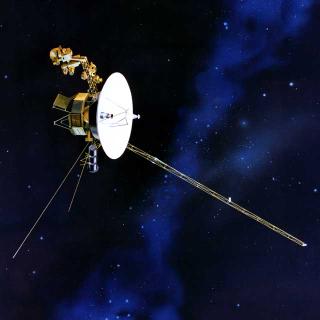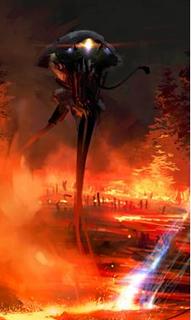
So we're going back to the moon, maybe even Mars. How come we're not excited about it?
Could be it has something to do with NASA's recently unveiled designs for the vehicles that will replace the shuttle and be able to do all this. Not that they won't work, or that they aren't a wonderful exercise in practicality and utility. It's just that they're not, well ... sexy.
To a public jaded by the racy designs of Star Wars and other sci-fi epics, the new plans seem so pedestrian, with a bit of a retro flare. The capsule on top--right, a capsule--harks back to the original designs of the Mercury, Gemini and Apollo programs, and those are up to forty years old. The lunar landing arrangement is merely a souped-up Apollo with LEM variation. And the basic earth-to-orbit design, a pencil with an eraser on top, most closely resembles the original Mercury/Redstone sub-orbital hardware. Even the landing method--parachutes and airbags--seems a let down after watching those shuttle landings that can only be termed, appropriately enough, "death defying."
On one hand, we should be glad to see our tax dollars being spent in as economical a way as possible, given the task. On the other hand, it is an admission that the whole space-plane concept of the shuttle was a mistake, or at least an idea ahead of its time. But it feels as if, at the end of World War II, with the existence of buzz-bombs and V-2 rockets well known, the government had announced its plan to build a new and improved biplane instead of trying to break the sound barrier.
The very idea that we have not been back to the moon in thirty years is enough to make you wonder what we've been up to. If, instead of squandering all our money on shuttle development and two space stations of dubious utility (letting the first one, Skylab, burn up in the atmosphere for lack of funding), suppose we had continued to fund the existing Apollo program for all that time. Plans had already been made to add an extra stage to the Saturn V through orbital rendezvous, which would have made it possible to land enormous payloads on the moon. We might have had a thriving lunar colony by the 1980's for a fraction of what it will cost us now. Instead, as soon as the "moon race" was won, we lost interest and shut the project down.
Maybe a new space race is what we need to spur the technological development process. We already have plenty of competition from Europe and Japan when it comes to launching commercial satellites with disposable rockets. And Burt Rutan is showing us what private companies can do with a little financial incentive. (When he builds a space plane, it looks like one.)
All that's missing is the kind of rivalry that put national prestige on the line during the Cold War, and it looks like the Chinese are about to provide that. By calmly following their own timetable, and pretty much ignoring what the US, Europe and Russia are up to in space, it won't be long before they provide us with the kind of surprise that the first sputnik gave us. And if that gets us moving again, so much the better.
Friday, September 30, 2005
Another Space Race
Posted by
The Nort
at
6:25 AM
0
comments
![]()
![]()
Tuesday, September 27, 2005
Cosmic Perspectives, Part 2: Voyager

The second thing that captured my imagination this week was the report that Voyager 1 has entered the next stage of its departure from our solar system by crossing the "termination shock" that marks the beginning of the "heliopause."
It's wonderful the way we find these new structures wherever we look, and the edge of the solar system is no exception. You might have thought that waving bye-bye to Neptune and Pluto would mark the probe's entry into empty interstellar space, but it turns out there is a detectable bubble of particles blown out by the sun, and a form of shock wave where the particles slow down from millions of miles per hour to radically slower speeds--maybe even reversing direction back toward the sun like waves lapping on a cosmic beach. This fuzzy line marks the region where the pressure of particles blowing in from other stars becomes more powerful than that of our own sun. Only when it travels beyond this region, which will take another few years, will Voyager enter true interstellar space and become our first probe to the stars.
Voyager wasn't the first vehicle to officially leave the solar system. In 1983 Pioneer 10 first passed the orbit of Neptune while it was temporarily the most distant planet from the sun due to Pluto's eccentric orbit. At the time NASA broadcast its bleeping radio transmissions to mark the event. There was even a toll-free number you could call to hear it live, 24-hours a day. (Had there been an Internet at the time, it would have been online as well, but the Internet had yet to develop.) And yes, I dialed that number and listened.
But Voyager is moving faster, and in 1998 it surpassed Pioneer 10 as the most distant man-made object.
More years have passed, and Voyager is still in the process of leaving. The boundary is that wide. The mission is thirty years old, and the probe may continue to function for another ten or fifteen years. It is now over eight billion miles out--twice the distance to Pluto--and by the time it expires it will be out over ten billion miles. But that will be only two-tenths of one percent of a lightyear, and the nearest star is over four lightyears away, and in a different direction.
Even so, I find this more exciting than anything that has happened in space exploration since the manned moon landings. (More on them another time.) As someone who has grown up through the era of rocketry, I have followed it since I was a small child, when Werner Von Braun and his team of German scientists founded the US missile program, and later the space program. I used to have a scrapbook filled with every photo I could find of rockets and satellites. I even kept a log as each satellite and space probe was launched, giving it up as hopeless when the launches reached into the hundreds (now thousands).
There have been many firsts over the years. Some of them were significant: the first satellite in orbit, the first human in space, first probes to the moon and other planets, first people to visit the moon. Others were merely of passing social interest, or of concern in the "space race" between the USA and the USSR: the first woman, first "space walk," first orbital rendezvous, or the first [insert your nationality here] in space.
There will be other such firsts as we venture forth from our planetary home. And there may be other "space races" in our future--are you watching the Chinese? But there will always be Voyager 1, this first tendril of human construction, a mere bucket of bolts, drifting out among the stars like a bottle in the ocean, bearing a message in case it ever washes up on some far shore, a message that says, "we were here," and which may be read when the human race is no more than an archeological relic.
Posted by
The Nort
at
6:36 PM
1 comments
![]()
![]()
Saturday, September 24, 2005
Cosmic Perspectives, Part 1: Distant Light
When I was a kid, the age of the earth had been pegged pretty accurately at around four billion years--quite a difference from the Biblical estimates of four thousand (only a small fraction of human history). The rest of the universe was thought to be somewhat older, but perhaps not more than double that figure, or around eight billion years. Gradually, astronomers refined the figure upward till it exceeded ten billion. But the aging process didn't stop there. Current estimates range from eleven to as high as twenty billion years. (To get some idea of how the calculations are done, check this out, or Google the age of the universe.) The estimates vary so widely because there is still so much we don't know, such as how much "dark" matter and energy is out there--the existence of which was only recently discovered.
Normally most of us don't think about all this very much, except while watching an episode of Nova on PBS. But the other day something brought it all home to me in a new way. It was reported that astronomers had detected the explosion of a star twelve billion light-years distant--meaning, of course, that the explosion happened twelve billion years in the past, and the news of the event, traveling at the speed of light, has only now arrived.
It's one thing to consider millions of galaxies being that far away, but there was something peculiarly nostalgic and evocative about one particular individual star being singled out over such a huge distance. I felt as if a window to the past had suddenly opened, leaving me gazing across this vast stretch of space and time the way Gatsby stared across his lake at the dim beacon that marked the home of his lost and unattainable love.
So, twelve billion years ... the place is at least that old--older, because the star had already formed and burned for at least some millions of years before it blew up. And it is at least that large in all directions from here. Does that mean it's twice twelve billion? Or even larger/older? Or is that just a trick of perspective, due to space itself being curved?
Maybe, in the fullness of time, we will have lifted our heads high enough to see beyond the cosmic horizon, and know the answer. Until then, let this lonely beacon be a sign to us of all we have learned, and all we have yet to learn.
Posted by
The Nort
at
11:39 AM
0
comments
![]()
![]()
Sunday, September 04, 2005
The World of Wars


War of the Worlds, Peace, Power and Disaster
Only about a dozen years ago news commentators were speculating about the arrival of a Pax Americana--a period of global peace and prosperity that would follow the Cold War as the United States of America, at last the only super-power, presided over a "new world order." Such a hopeful phrase ... in the words of performance artist Laurie Anderson, it may not have been very specific, "but at least it promised to be something new, and worldwide, and orderly."
The reality has turned out to be something less than peaceful, all too familiar, and far from orderly, though certainly worldwide. America has emerged as an empire, and not a very nice one. Plagued like ancient Rome by "barbarians" at home and abroad, it has lashed out and in the process rediscovered the limits of military force.
Perhaps this sense of inadequacy is haunting us as a nation. That could explain the compelling nature of Steven Spielberg's remake of H. G. Wells' War of the Worlds. Though shrill (someone should explain to the Tom Cruise character that the best way to calm a hysterical child is NOT to yell at her), it is nevertheless a vivid portrayal of what happens when society breaks down in the face of something it cannot control. The aliens are as technologically superior to us as, let's say, a cruise missile is to a cavalry charge on camel back. In one stroke--a scientifically accurate electromagnetic pulse--all communication and transportation is knocked out, reducing us to the status of vermin ready to be symbolically stepped on by the strides of the towering alien machines. Instantly, it's everyone for themselves.
This is an interesting contrast to what happened only a couple of years ago when our President visited Hollywood to get them to help whip up some war fever. There was a marked increase in the production of heroic new films, and an immediate abundance of old ones unearthed to be aired on television. A particular favorite of mine was Paul Verhoeven's take on Robert Heinlein's Starship Troopers, where the infantry heroes battle giant insects (the perfectly dehumanized enemy) in a landscape uncannily like that of Afghanistan. It didn't seem to bother anyone that the world government on earth had the militaristic trappings of the Third Reich, or that citizenship was not universal but had to be earned by things like, well, military service for example. Legislation anyone?
But it doesn't take a war or a superior enemy to deliver the nightmare of national impotence. Look what a handful of terrorists were able to do by redirecting the paths of a few airplanes. And see how we throw up our hands in helplessness when confronted with the wholesale destruction of a city by the natural forces of wind and water. Pulling triggers is easy compared to providing for the human needs of human beings. When we stop taking aim and start taking time to tend to the real needs of those at home and abroad, maybe then historians will be able to identify the Pax that emerged from this chaos, and to name a date when we finally outgrew our need to be powerful.
Posted by
The Nort
at
10:30 PM
0
comments
![]()
![]()
Labels: movies, science fiction, World War









